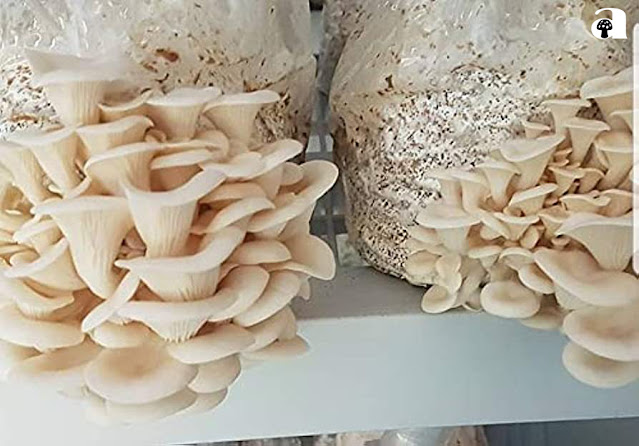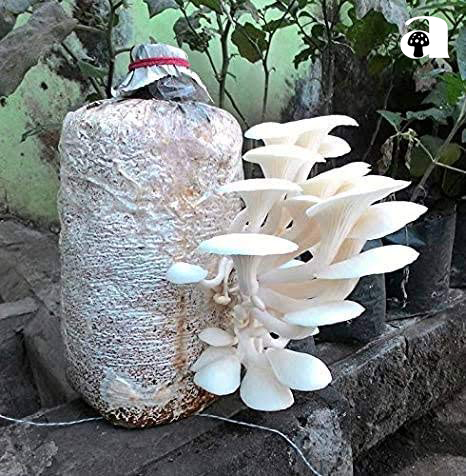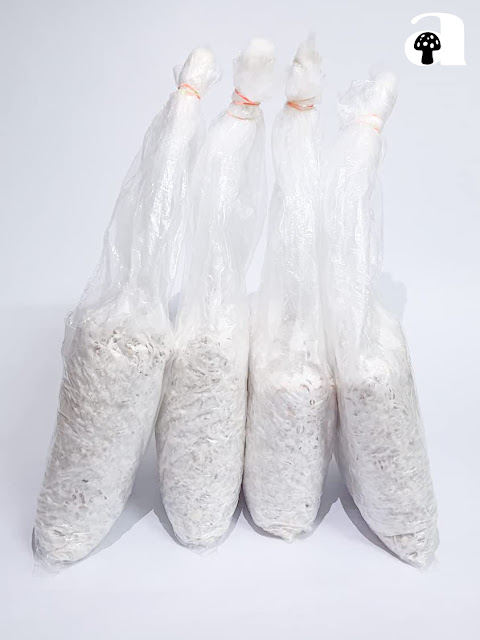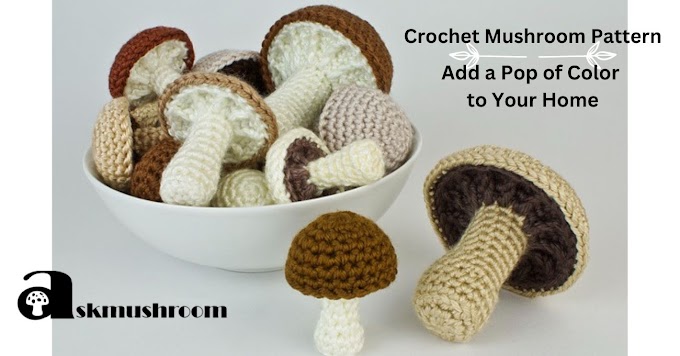Seed mushroom is another term for mushroom spawn, which is the mycelium of a mushroom species with its seed substrate. Mycelium is the fungal network that grows underground and produces mushrooms as its fruit. Mushroom spawn can be made from different types of grains, such as wheat, rye, millet, or sorghum. Mushroom spawn is used to inoculate the substrate or growing medium for mushroom cultivation.
There are different types of seed mushroom spawn, depending on the species of mushroom and the method of cultivation.
Some common types are:
•Sawdust spawn: This is made from hardwood sawdust that is sterilized and inoculated with mushroom mycelium. It is used for growing mushrooms on logs, straw, or wood chips.
•Grain spawn: This is made from whole or crushed grains that are sterilized and inoculated with mushroom mycelium. It is used for growing mushrooms on compost, manure, or straw.
•Plug spawn: This is made from small wooden dowels that are inoculated with mushroom mycelium. It is used for growing mushrooms on hardwood logs by drilling holes and inserting the plugs.
•Liquid spawn: This is made from a liquid culture of mushroom mycelium that is injected into a substrate or sprayed on a surface. It is used for growing mushrooms on cardboard, paper, or coffee grounds.
Mushroom spawn should be stored in a cool, dark, and dry place to prevent contamination and premature fruiting.
The optimal storage temperature depends on the type of mushroom, but generally ranges from 0°C to 10°C2. Mushroom spawn should be used within a few weeks or months of purchase, depending on the species and quality.
How do I make my own seed mushroom spawn?
There are different methods to make your own mushroom spawn, depending on the type of mushroom and the level of expertise you have. One of the simplest ways for beginners to start growing their own mushroom spawn is using the stem butt method1. This method involves using the stems of oyster mushrooms and some damp cardboard as the substrate.
Here are the steps to follow:
•Get your cardboard ready: You’ll need to find some large pieces of cardboard that you can shred into smaller pieces. Avoid cardboard that has a lot of ink or glue on it, as this can inhibit the growth of the mushroom mycelium.
•Wet your cardboard: Next, you need to get your cardboard wet. Mushrooms need a moist and humid environment to grow, so you want to soak your cardboard pieces in water for a few minutes until they are fully saturated. Then squeeze out the excess water and leave them in a colander or a strainer to drain.
•Prepare your mushroom stems: You’ll need some fresh oyster mushrooms that have healthy and intact stems. Cut off the bottom part of the stems, about an inch or two, and save them for later. You can use the rest of the mushrooms for cooking or eating.
•Layer your cardboard and mushroom stems: Find a suitable container for your spawn, such as a plastic box or a glass jar with a lid. Make sure it’s clean and dry before you start. Then layer your cardboard pieces and mushroom stems alternately, starting and ending with cardboard. You want to create a sandwich-like structure with the mushroom stems in between the cardboard layers. Don’t pack it too tightly, as you want to leave some air space for the mycelium to grow.
•Close the container and store it: Once you have filled your container with cardboard and mushroom stems, close it with a lid and poke some holes on it for ventilation. You can also cover it with a breathable cloth or paper towel instead of a lid. Then store it in a dark and warm place, such as a cupboard or a closet, where the temperature is around 20°C to 25°C.
•Wait for the mycelium to colonize: After a couple of weeks, you should see some white fuzzy growth on the cardboard and mushroom stems. This is the mycelium of the oyster mushrooms, which is spreading and colonizing the substrate. You can check on it every few days and mist it lightly with water if it looks too dry. Don’t open the container too often, as this can introduce contaminants or disturb the mycelium growth.
•Use your spawn: When your cardboard is fully covered with mycelium, you have successfully made your own mushroom spawn! You can use it to inoculate another substrate, such as straw or wood chips, to grow more mushrooms. Or you can store it in the fridge for up to a month until you’re ready to use it.
This is one way to make your own mushroom spawn at home without much equipment or expertise. However, if you want to grow other types of mushrooms or produce larger quantities of spawn, you may need more advanced methods that involve sterilization, agar plates, grain jars, and a clean room. These methods are more complex and require more skills and resources, but they can also yield more consistent and reliable results.
Some advantages of making your own seed mushroom spawn are:
•You can save money by using materials that are readily available or cheap, such as cardboard, grains, or wood chips.
•You can experiment with different types of mushrooms and substrates, and find the ones that suit your preferences and conditions best.
•You can learn more about the biology and ecology of mushrooms and how they grow and interact with their environment.
•You can have a sense of satisfaction and accomplishment from creating something from scratch and watching it grow and produce mushrooms.
Some disadvantages of making your own seed mushroom spawn are:
•You may need to invest in some equipment and supplies, such as jars, pressure cooker, agar, petri dishes, etc., depending on the method you use.
•You may face challenges with contamination, as mushrooms are very sensitive to bacteria, mold, and other microorganisms that can ruin your spawn or your mushrooms.
•You may need to spend a lot of time and effort to maintain a sterile environment and follow the steps carefully to ensure the quality and viability of your spawn.
•You may not get consistent or reliable results, as mushroom spawn production can be affected by many factors, such as temperature, humidity, light, air flow, etc.
Some signs of good seed mushroom spawn are:
•The spawn has a uniform and dense growth of white mycelium that covers the substrate completely.
•The spawn has a fresh and earthy smell, without any sour or unpleasant odors.
•The spawn has a firm and moist texture, without any slimy or dry patches.
•The spawn does not have any visible signs of contamination, such as mold, bacteria, insects, or other colors.
There are many types of mushroom spawn, depending on the species of mushroom and the substrate used.
Some common types are:
Sawdust spawn: This is made from hardwood sawdust that is sterilized and inoculated with mushroom mycelium, most commonly by grain spawn. It is used for growing mushrooms on logs, straw, or wood chips.
Grain spawn: This is made from whole or crushed grains that are sterilized and inoculated with mushroom mycelium. It is used for growing mushrooms on compost, manure, or straw.
Plug spawn: This is made from small wooden dowels that are inoculated with mushroom mycelium. It is used for growing mushrooms on hardwood logs by drilling holes and inserting the plugs.
Liquid spawn: This is made from a liquid culture of mushroom mycelium that is injected into a substrate or sprayed on a surface. It is used for growing mushrooms on cardboard, paper, or coffee grounds.
Some examples of mushroom species that can be grown using these types of spawn are:
Button mushrooms (Agaricus bisporus): These are the most common and widely cultivated mushrooms. They can be grown using grain spawn or sawdust spawn on composted manure or straw.
Oyster mushrooms (Pleurotus spp.): These are versatile and easy to grow mushrooms. They can be grown using any type of spawn on various substrates, such as straw, wood, cardboard, or coffee grounds.
Shiitake mushrooms (Lentinula edodes): These are popular and nutritious mushrooms. They can be grown using sawdust spawn or plug spawn on hardwood logs, such as oak or maple.
Portobello mushrooms (Agaricus bisporus): These are large and meaty mushrooms that are actually mature button mushrooms. They can be grown using the same methods as button mushrooms.
Morel mushrooms (Morchella spp.): These are highly prized and delicious mushrooms that are difficult to cultivate. They can be grown using liquid spawn on wood chips or straw mixed with soil.
To choose the best type of mushroom spawn for your needs, you should consider the following factors:
The type of mushroom you want to grow:
Different mushroom species have different requirements and preferences for the substrate, temperature, humidity, and light. You should choose a type of spawn that matches the mushroom you want to grow and that is compatible with the substrate you have available.
The amount of mushroom you want to produce:
Different types of spawn have different yields and production times. Generally, grain spawn produces more mushrooms faster than sawdust spawn or plug spawn, but it is also more expensive and prone to contamination. Liquid spawn can produce a lot of mushrooms quickly, but it is also more difficult to handle and store. You should choose a type of spawn that suits your budget and your desired quantity and frequency of mushroom harvests.
The level of skill and experience you have:
Different types of spawn have different levels of difficulty and complexity to use. Generally, sawdust spawn and plug spawn are easier and simpler to use than grain spawn or liquid spawn, but they also require more time and space. Grain spawn and liquid spawn require more sterilization and inoculation techniques, but they also offer more flexibility and efficiency. You should choose a type of spawn that matches your level of skill and experience and that you feel comfortable working with.
Where can I buy seed mushroom spawn?
You can buy mushroom spawn from various sources, depending on your location and preference. Some possible options are:
Online platforms: You can order mushroom spawn from online platforms, such as Amazon, IndiaMART, or JMP Mushroom, that offer a wide range of mushroom species and types of spawn.
You can also find reviews and ratings from other customers to help you choose the best quality and price. However, you may have to pay for shipping and handling fees, and you may not be able to inspect the spawn before buying it.
Government agencies: You can buy mushroom spawn from government agencies, such as the Indian Council of Agricultural Research or the Ghana Agroecological Institute, that provide mushroom spawn for research and development purposes. You may be able to get high-quality and certified spawn at a subsidized rate, but you may also have to follow certain procedures and regulations to obtain it.
Local suppliers: You can buy mushroom spawn from local suppliers, such as mushroom farms, nurseries, or cooperatives, that produce and sell mushroom spawn in your area. You may be able to get fresh and reliable spawn at a reasonable price, and you may also be able to visit the production site and see how the spawn is made. However, you may have limited options in terms of mushroom species and types of spawn, and you may have to travel to the location to buy it.



.jpg)
.jpg)
.jpg)
.jpg)

.jpg)






.jpg)





